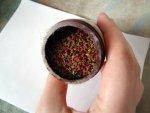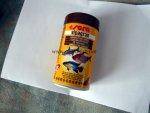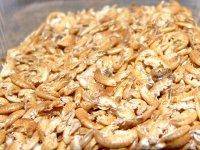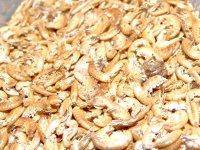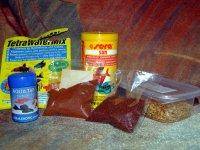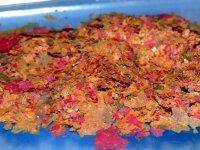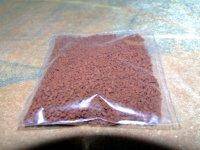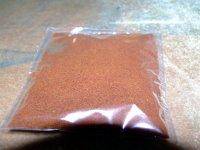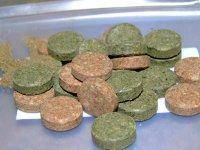Feeding Aquarium Fish: Types, Tips, and Dietary Guidance
Quick links - Answers
Brief Description
Feeding freshwater tropical fish is a crucial aspect of successful fishkeeping. The type of food you provide should be carefully chosen based on the species you have, as explained in detail below.
Importance of Proper Fish Nutrition
Ensuring that your aquarium fish receive the right diet is essential for their health and overall well-being. The benefits of providing appropriate nutrition extend beyond just keeping your fish fed - they play a significant role in maintaining a thriving aquatic environment.
- Prevent diseases in the tank,
- Keep your fish active and energetic,
- Enhance your fish's coloration,
- Encourage breeding behavior,
- Support proper growth in fry.
Smaller, regular meals are metabolically easier and reduce uneaten waste compared to one large feeding.
Fish Food Categories
Fish food can generally be categorized into two main types: live food and prepared (or "lifeless") food. However, fish typically require a variety of foods, as their dietary needs can vary widely depending on several factors such as their natural habitat, the current season, their position in the food chain, size, and feeding habits.
While dividing food into live and prepared types is a good start, a more nuanced classification based on dietary habits can help you better understand what to feed your fish. This classification includes:
-
Omnivores
Omnivorous fish consume both animal and plant matter. Contrary to popular belief, omnivores need a balanced diet that includes both vegetables and live food, along with appropriate water conditions and lighting. Most home aquarium fish are omnivores, even if they are often mistakenly thought to be herbivores.
-
Herbivores
Herbivorous fish feed exclusively on plant-based food. While many catfish species are considered herbivores, they often enjoy occasional meat-based food as well.
-
Carnivores
Carnivorous fish primarily eat meat. This group includes species like many African cichlids. Carnivores are often more aggressive and should not be housed with more vulnerable species.
To ensure your fish receive the right nutrition, it is important to choose food that meets the following criteria:
- Food Size: The food must be small enough for the fish to consume easily. It should be less than the fish's mouth size and digestive tract size. Many fish have mouths larger than their digestive tracts, so if the food is too large, the fish may spit it out. They typically take small bites they can manage. Leftover food can settle at the bottom of the tank, so keeping bottom-dwelling fish such as catfish, Corydoras, and Plecos can help clean up any uneaten food.
- Nutritional Content: The food must be rich in essential nutrients and vitamins to maintain a healthy aquarium. For more information on the importance of vitamins and proper feeding, please refer to our detailed guide.
We can further categorize fish food into specific types based on common freshwater species. Here’s a general guide for each group:
- African Cichlids: Feed with cichlid flakes, pellets, and beef heart.
- Angelfish: Offer granules, bloodworms, flakes, brine shrimp, and frozen food.
- Barbs: They thrive on flakes and frozen food.
- Betta Species: Suitable foods include bloodworms and granules.
- Catfish: As bottom-dwellers, they enjoy vegetable or meat tablets but will also eat flakes if accessible. They also favor frozen beef heart and tubifex.
- Danios: They primarily eat flakes.
- Discus: Feed them freeze-dried bloodworms, brine shrimp, and granules.
- Goldfish: Suitable foods include pellets, flakes, and granules.
- Gourami Fish: They prefer granules and tablets but will also consume beef heart.
- Loaches: They thrive on wafers, flakes, and frozen food.
- Plecos: Provide tablets, flakes (if they can reach the top levels), frozen food, and tubifex.
- Rainbowfish: They primarily eat flakes.
- Rasboras: Mostly prefer flakes and granules.
- Sharks: Suitable foods include frozen food and beef heart.
- Tetras: Most tetra species are small fish that prefer granules, tablets, and flakes.
While the general guidelines cover most feeding needs, you can offer additional food options based on your fish species. For carnivorous fish, consider feeder goldfish (small goldfish bred specifically as live food), small guppies, mollies, platies, and others.
Note: Feeder fish can introduce disease and, in some cases (e.g., goldfish), contain thiaminase which degrades vitamin B1. If you use live feeders, quarantine and source responsibly—and consider safer alternatives like home-raised livebearers or prepared high-protein diets.
However, be cautious not to overfeed your fish. Although some species can consume large quantities, less is often better. Excessive feeding can lead to obesity, resulting in health issues, swimming problems, and degraded water quality due to decomposing uneaten food. Leftover food can foster fungal growth and may eventually be drawn into the filter, impacting all tank inhabitants.Feeding Tips
Beef heart can enhance the coloration of fish, but it has drawbacks. Fish may become overly reliant on it, potentially neglecting other essential foods. Additionally, it can lead to obesity in fish. In contrast, vegetables are rich in vitamins and should be included in their diet. However, if fish are not introduced to vegetables from a young age, they may refuse to eat them later on.
Feeding should align with your fish's appetite, generally requiring feeding twice a day. Random feeding is not advisable, although it is natural in the wild where there is no set 'feeding time.'
Exceptions apply: nocturnal or predatory species may prefer a single, well-timed meal. Always tailor timing and portions to your specific stock and observe leftovers.
If you are breeding fish, follow these specific feeding guidelines:
- Increase the amount of live food during the breeding period to stimulate breeding. Avoid meat-based foods for herbivores.
- Feed fish more frequently than usual during breeding.
- Fry typically accept Artemia Salina. Alternative foods can lead to problems and high mortality rates. Feed juvenile fish up to five times a day.
Remember, quality often comes at a higher price, but investing in high-quality food is better than frequently replacing your fish. Avoid low-quality foods to ensure your fish remain healthy, vibrant, and active. The last thing you want is for your aquarium to look lifeless.
Schedule matters—use timers or an automatic feeder to keep meals consistent when your routine changes.
Video Resources
Check out our video on fish feeding here (approximately 38 MB, 640x480px). Additionally, we have another video showing fish being fed bloodworms, available here (approximately 110 MB).
Images
We do not promote any products. The images provided are for illustrative purposes only.
Automatic Fish Feeders: Setup & Buyer’s Guide
Automatic feeders keep feeding consistent and prevent “double feeding” when more people care for the tank. Used well, they reduce waste and help stabilize water quality. They’re ideal for daily routines and vacations—just remember they still need occasional human checks.
Buyer’s Checklist
- Food compatibility: pellets/granules flow best; flakes tend to clump unless the hopper is well sealed and ventilated.
- Portion control & schedule: adjustable drum opening or dosing gate; at least 2–4 programmable feedings/day or interval mode.
- Moisture control: covered hopper, optional ventilation, and a feeder ring on the water surface so food doesn’t get blasted into the filter.
- Power & reliability: battery operation with low-battery indicator is safest; a manual feed button is handy for spot-feeding.
- Mounting: clamp or adhesive bracket on the rim/hood; aim the outlet over a calm area (not directly above splashing returns).
- Capacity: size the hopper for 1–3 weeks of food; larger isn’t always better—stale food absorbs humidity.
Setup & Calibration (2–3 days)
- Dry test: Run the feeder into a dry cup; inspect dose size and uniformity.
- Live trial: Mount it and let it feed your fish for 2–3 days while you observe. Tweak the opening until fish finish food quickly without leftovers.
- Food choice: Prefer micro-granules for small fish; for flakes, keep a small desiccant (silica gel) near the hopper and use a feeder ring.
Vacation Prep Checklist
- Install fresh batteries and fill with fresh, dry food.
- Run a full 7-day rehearsal before you leave; confirm there are no clogs and fish consume the dose.
- Ask helpers not to add extra food. If needed, leave pre-measured emergency portions.
Maintenance
- Every 2–4 weeks: wipe dust, crumbs, and salt creep; check the drum and gate for buildup.
- Refill little and often to keep food fresh; store bulk food airtight, away from humidity and heat.
Feeder FAQ
-
Do automatic feeders work with flakes?
Yes, but flakes absorb moisture and clump more easily. Use a covered hopper, keep the area dry, and consider switching to micro-granules for reliability.
-
How many times per day should it feed?
Most community tanks do well with 2 small meals per day. Messy eaters (e.g., big cichlids) may need a single, slightly larger meal to avoid excess waste.
-
Why is food piling in my filter intake?
Direct the outlet over a calm surface and use a feeder ring. Strong surface current can scatter food immediately into the overflow/intake.
-
Can I dispense frozen or wet food?
No. Automatic feeders are for dry foods only. For frozen/live foods, feed manually or use alternative routines while you’re home.
-
My feeder got damp and jammed—what now?
Empty and dry the hopper, gently clean the drum/gate, switch to granules, and relocate the unit away from splashes. Consider a small desiccant nearby.
Questions and Answers about Fish Food
We’ve relocated these frequently asked questions from aqua-fish.net/answers to consolidate all related information in one place. If you can’t find the answer to your question here, please use the form at the bottom of the page, and we’ll do our best to address all inquiries related to fish food. (Some questions may be partially addressed earlier on this page)
-
What do Blue Gouramis eat?
Answer: Blue Gouramis eat both meat-based and vegetable-based foods. You can offer them Spirulina flakes, granules, or bloodworms. Additionally, they can consume Ramshorn snails if they are accustomed to eating them.
-
What does Bristlenose Catfish eat?
Answer: Bristlenose Catfish are omnivores, so they can eat a variety of foods. They particularly enjoy bloodworms and JBL flakes.
-
When should you feed Discus fish?
Answer: Discus fish should be fed twice a day, once in the morning and once in the evening.
-
Why does my Oscar fish eat so much?
Answer: Oscar fish are known for their hearty appetites and will continue eating as long as food is provided. To prevent overfeeding, offer a balanced diet and be mindful not to overfeed, as these fish produce a significant amount of waste.
-
Why do clown loaches make a clicking sound when they eat?
Answer: Clown loaches produce a clicking noise when they are satisfied, especially while eating. This sound is a sign that they are content.
-
Which fish eat green algae?
Answer: Many algae-eating fish consume green algae, but there is no specific color group that specializes in eating it. Most algae eaters will graze on green algae.
-
What fish are effective at eating green hair algae?
Answer: Fish such as American flag fish, Bristlenose catfish, and Cherry shrimp are known to feed on green hair algae. Chinese algae eaters will also consume green hair algae, but they prefer it when the algae is young.
-
Which tropical plants are safe from being eaten by Sailfin plecos?
Answer: A well-fed Sailfin pleco will generally avoid eating plants and prefer algae and prepared algae tablets. They will only eat plants when no other food sources are available. You can gauge their health by checking the shape of their belly: a rounded belly indicates they are well-fed, while a caved-in belly suggests malnutrition.
-
How can you tell if your Platy fish is receiving enough food?
Answer: If your Platy fish is healthy and active, it is likely getting enough food. Monitor its growth and check the size of its belly - if it appears consistently bloated, this may indicate overfeeding. Balance is key to avoid health issues.
-
What do Archer fish eat?
Answer: Archer fish consume a varied diet including flake food, bloodworms, ants, flies, moths, and crickets.
-
What do Black Skirt Tetra fish eat?
Answer: Black Skirt Tetras will eat a variety of foods including flake food, pellets, bloodworms, and almost anything else you provide.
-
What do freshwater snails eat?
Answer: Freshwater snails consume algae, aquatic plants, flake food, frozen foods, and live foods. They are also known for cleaning up leftover food from the tank.
-
What do freshwater clams eat?
Answer: Freshwater clams are filter feeders that consume debris and leftover fish food by filtering it from the water.
-
What do Firemouth Cichlids eat?
Answer: Firemouth Cichlids enjoy a diet of algae, flake food, pellets, dried krill, bloodworms, tubifex worms, and brine shrimp.
-
What do Gold Dojo Loaches eat?
Answer: Gold Dojo Loaches accept flake food and pellets, but they also enjoy earthworms and small fish.
-
What do Goldfish eat?
Answer: Goldfish will eat a variety of foods. A good quality pellet should be the base diet, supplemented with mealworms, earthworms, fruits, vegetables, and frozen peas (without skins).
-
What do Green Terror Cichlids eat?
Answer: Green Terror Cichlids thrive on a diet of bloodworms, fish, beef, vegetables, and a high-quality pellet base diet.
-
What do Platies eat?
Answer: Platies will eat flake food, pellets, brine shrimp, and other small live foods.
-
What do Honey Gourami eat?
Answer: Honey Gourami thrive on high-quality flake or pellet food, with live food offered occasionally as a treat.
-
What do Pictus Catfish eat?
Answer: Pictus Catfish enjoy a diet of bloodworms, beef heart, insects, pellets, flake food, and can also eat vegetables like skinned peas and lettuce.
-
What do Rainbowfish eat?
Answer: Rainbowfish consume algae, vegetables such as pumpkin and zucchini, small insects, small fish, mosquito larvae, and fruit flies.
-
What do Siamese Algae Eaters eat?
Answer: Siamese Algae Eaters have a varied diet including pellets, algae, small worms, insect larvae, beef heart, vegetables, and flake foods. They prefer planted tanks where they can easily find food.
-
What do Tiger Barbs eat?
Answer: Tiger Barbs eat flake food, granules, pellets, worms, tubifex, and tablets.
-
What do Mosquito Fish eat?
Answer: Mosquito Fish prefer mosquito larvae but will also eat high-quality pellet or flake food. They can be supplemented with insect larvae, brine shrimp, and bloodworms.
-
What do Algae Eaters eat?
Answer: Algae Eaters primarily consume algae but also help clean up excess food and any deceased fish in the tank.
-
What do Panda Corydoras eat?
Answer: Panda Corydoras enjoy a diet of high-quality flake food, pellets, and live foods like white or black worms, tubifex worms, brine shrimp, and micro worms.
-
What does a False Black Tetra eat?
Answer: Feed False Black Tetras with flake food and small live foods such as insects and brine shrimp.
-
What do Raphael Catfish eat?
Answer: Raphael Catfish feed on bloodworms, brine shrimp, and frozen fish foods.
-
When should Cherry Barb fry be fed?
Answer: Cherry Barb fry should be fed as soon as they have absorbed their yolk sacs. Start with infusoria or a liquid fry food for the first two weeks, then gradually introduce newly hatched brine shrimp. Feed them 2-3 times per day.
-
Why is uneaten food accumulating in my tank?
Answer: Uneaten food is often a sign of overfeeding, which can quickly foul the water. Reduce the amount of food provided and check the health of your fish if the problem persists.
-
When should you start feeding African Dwarf Frog tadpoles?
Answer: Newly hatched tadpoles can be challenging to feed. Start by offering them newly hatched brine shrimp to encourage them to eat.
-
What do pond Goldfish eat?
Answer: Even though pond Goldfish are in an outdoor environment, continue feeding them a high-quality dry pellet diet. They will also consume bug larvae and plant matter as a supplement.
-
What do Chinese Algae Eaters eat?
Answer: Juvenile Chinese Algae Eaters primarily consume algae. However, as they grow, they will need additional food such as flake food and pellets, and they will also eat any excess food left by other tank mates.
-
What should I feed Green Terrors?
Answer: Green Terrors will eat a wide range of foods. A varied diet including bloodworms, mosquito larvae, and pellets is beneficial. Experiment with different live food options to determine their preferences.
-
What should I feed Koi Carp?
Answer: Koi Carp should be given high-quality pellets and supplemented with live food and vegetables to ensure they receive all necessary vitamins for optimal health.
-
What do Rainbow Sharks eat?
Answer: Rainbow Sharks are omnivores. Provide a varied diet starting with flake or pellet food and include vegetables like lettuce and brine shrimp as supplements.
-
What should I feed Kuhli Loaches?
Answer: Kuhli Loaches are bottom feeders and do well with sinking pellets as their main diet. Offer live foods occasionally for variety.
-
What vegetables should I feed my Oscar fish?
Answer: Oscars are primarily carnivorous. Their diet should be mainly meat-based, but cichlid pellets will provide essential vegetable matter.
-
What type of fish can eat algae and live with Tetras?
Answer: Corydoras are generally peaceful and consume algae. Alternatively, snails such as Apple or Ramshorn snails are non-predatory and will clean the aquarium surfaces. Another option is the "pleco," though they can grow large, prefer warmer temperatures, and may become aggressive or try to eat other fish's slime coat.
-
What food should I give Catfish?
Answer: The diet for Catfish depends on their species. Herbivorous Catfish should be given a diet rich in vegetables like cucumber and peas, along with spirulina pellets. Carnivorous species require a high-protein diet, including bloodworms, cockles, and mussels.
-
What diet should I feed my Flowerhorns?
Answer: Flowerhorns should be fed high-quality cichlid pellets at least twice a day, ideally three times. This diet will meet their nutritional needs, but occasional treats of brine shrimp or bloodworms are also beneficial.
-
Which fish eat Tetra Bettamin?
Answer: Tetra Bettamin is specially formulated for Betta fish, providing essential nutrients and color enhancers to boost fin coloration.
-
What makes a Goldfish grow fast?
Answer: A healthy diet and ample swimming space are key factors for a Goldfish to reach its full size. While it may not grow rapidly, these factors ensure optimal growth.
-
What meat should I feed a Piranha?
Answer: Piranhas can be fed strips of beef or a processed beef heart mix. Juvenile Piranhas may eat flake foods, but adults require a meat-based diet.
-
What shouldn’t I feed my Tiger Barbs?
Answer: Tiger Barbs accept a wide range of foods including flakes and pellets. There is no specific food to avoid, but any food they dislike will be left uneaten.
-
What should I feed my Oscar fish?
Answer: Oscars thrive on specially formulated cichlid pellets. Additionally, offer frozen brine shrimp, Krill, and Beef heart 2 to 3 times per week. Earthworms are also acceptable but should be thoroughly cleaned before feeding.
-
When should I feed my Ghost Knife fish?
Answer: Although Ghost Knife fish are nocturnal, they can be trained to come out during the day for feeding. Offer small amounts twice daily.
-
What should I feed my Black Tropheus?
Answer: In their natural habitat, Black Tropheus feed on algae from rocks. Their diet should be algae-based, supplemented with brine shrimp. Allow some algal growth in the tank to mimic their natural diet.
-
What should I feed Paradise fish?
Answer: Provide Paradise fish with a varied diet of flakes, spirulina flakes, and brine shrimp. Additional treats can include bloodworms, plankton, and small earthworms.
-
What should I feed my Amano shrimp?
Answer: Amano shrimp primarily feed on algae, which is why they are often added to planted tanks. If algae is scarce, offer flake food and algae tablets.
-
What should I feed my Blue Rams?
Answer: Blue Rams enjoy bloodworms, mysis shrimp, and brine shrimp. For their main diet, use small-sized cichlid pellets and offer the treats occasionally.
-
What should I feed my Discus fish?
Answer: Discus fish require a varied diet to prevent boredom. Their diet should consist primarily of quality discus granules, supplemented with brine shrimp, bloodworms, and beef heart on alternate feeding days.
-
What food should I give my Koi for growth?
Answer: To promote growth in Koi carp, feed them a high-protein diet. This food is available in pellet form from various suppliers. However, avoid feeding them this diet when water temperatures drop.
-
What should I feed my Tire Track Eel?
Answer: Tire Track Eels should be fed a diverse diet including bloodworms, tubifex worms, glass worms, earthworms, and krill.
-
What should I feed my Tetra fry?
Answer: Newly hatched brine shrimp are a great option for Tetra fry. Additionally, crushed flake food will provide essential nutrients for their growth.
-
What can I feed my Flowerhorn to promote head growth?
Answer: Products like Maxima and Head Booster are designed to enhance head growth in Flowerhorns. For natural growth, providing a spacious tank and a varied diet will also encourage optimal head development.
-
What should I feed my Corydoras catfish?
Answer: Corydoras catfish should have a dedicated diet including shrimp pellets, algae wafers, and catfish pellets. They also appreciate occasional treats of bloodworms or Tubifex worms.
-
What should I feed my Gouramis?
Answer: A high-quality flake food should be used as the staple diet for Gouramis. Supplement their diet with treats like bloodworms and brine shrimp 2-3 times per week.
Of course, there are additional questions that our visitors frequently ask. Below are some of the most important ones, along with their answers.
How much should I feed my fish?
Many guides recommend feeding fish an amount that should be consumed within 1-5 minutes, with the specific number varying between sources. Personally, I use a different approach: I first add flakes to the aquarium to feed the fish that swim in the top or middle levels. As the flakes sink (they float for a few seconds to a minute, depending on the water flow), they eventually reach the bottom where bottom-dwellers can eat them. By this time, most fish except the bottom-dwellers are usually full. Then, I add granules and tablets, which sink immediately. Bottom-dwellers typically need more time to find the food, often taking more than a minute or two, unless there are so many fish that the food is eaten quickly.
Keeping snails in the aquarium can also be beneficial, as they consume any uneaten food, preventing it from decomposing and lowering the pH.
Always observe your fish during feeding time to ensure they are eating. For example, a small Tetra can consume 4-5 normal-sized flakes (about 1 cm²) at once. Foods like bloodworms or larvae are particularly appealing, and fish may eat more of these.
What is the best time to feed my fish?
For fish, feeding times can vary, but it's generally best to avoid feeding them during the night or when the aquarium lights are off. I feed my fish in the morning around 08:00 and in the evening at 19:00. If you introduce new fish to your tank, they will quickly learn the feeding schedule, usually within 4-5 days of acclimation to their new environment.
Fish tend to be more active during feeding times, so if you want to see them swimming around, feeding them will encourage this behavior. However, be careful not to overfeed.
What is Spirulina and How Does It Help?
Spirulina is an excellent dietary supplement for algae eaters and herbivorous fish. It is rich in protein, consisting of about 60% vegetable protein that is easily digestible and free from fats and cholesterol found in meat. For more detailed information on the benefits of Spirulina, you can read our dedicated article here: /articles/benefits-spirulina-food-aquarium-fish.
How Long Can Fish Live Without Food?
The duration varies by species. Large cichlids can often survive a few weeks, sometimes even months, without food. Coldwater fish, like Koi, can go without food during the winter months, although feeding them occasionally is still beneficial. Some livebearers, however, may only last a week without food. In my experience, Angelfish, Gouramis, and Bristlenose catfish can typically manage a week without food, with Bristlenose catfish possibly finding some algae to eat.
Instead of leaving your fish unfed, consider investing in an automatic feeder. If you’ll be away for less than 48 hours, your fish should be fine without any issues. Automatic feeders help deliver small, consistent meals; run a one-week rehearsal before any trip.
What is Natural Fish Food, and What Are Its Advantages and Disadvantages?
Natural fish food varies depending on the species you're feeding. For example, if you're interested in live food, you can place some dead carp in a river for a few days to attract larvae. When you return, you'll find plenty of larvae in the fish's body, which your carnivorous or omnivorous fish will enjoy. Another option is to collect larvae from puddles, which is best done in the summer. You can also create your own live food by setting up a temporary tank with water from other fish tanks, adding some fish food and sponge from a filter. Over a few weeks, you should see tubifex worms develop. However, these natural foods can introduce diseases into your aquarium. The benefit is that these larvae are relatively easy to cultivate and are eagerly consumed by fish.
For herbivorous fish, algae serves as an excellent natural food source. To promote algae growth, you need to use more lighting than usual and ensure that fish don’t consume all the algae at once. Essentially, the algae must grow faster than it’s eaten. The benefits of using algae include providing an accessible food source for newborns and helping to maintain water chemistry by breaking down harmful chemicals. There are no significant disadvantages to using algae as fish food.
Can Too Much Live Food Cause Dropsy Disease?
No, the amount of live food itself doesn't cause dropsy disease. However, even a small amount of live food can potentially lead to dropsy if the food is infected, particularly in weak fish. Infected food can introduce various diseases into the tank.
Is Leaving Uneaten Frozen Food in the Aquarium Bad?
Ideally, no uneaten food should be left in the aquarium. However, it's not always possible to ensure that all food has been eaten, and small pieces may fall to hard-to-find places. While uneaten food will decompose, this doesn't pose an immediate danger if managed properly.
To minimize issues with uneaten food, consider adding snails, such as Ramshorn snails, to the tank. Although they produce a lot of waste, they are effective at consuming leftover food. Alternatively, bottom-dwellers like Corydoras or Catfish can help clean up any remnants.
Can Beef Heart Be Used as Fish Food?
Yes, beef heart can be used as fish food, but it is not recommended for frequent use. Beef heart is not a natural food for fish and can potentially introduce diseases into the tank. While many fish may enjoy beef heart, it is akin to unhealthy food for humans - tasty but not necessarily beneficial. It is better to feed your fish a balanced diet of appropriate, commercially available foods to ensure their health and well-being.
How Do Fish Collect Food?
Fish mouths are adapted to their feeding habits. For instance, Betta fish have mouths oriented to collect food from the surface, while Cories and Catfish have mouths adapted to gather food from the bottom.
However, the size of a fish's mouth alone does not determine the size of food it can handle. Often, a fish's mouth may be larger than its digestive system. If the food is too large, the fish will typically spit it out.
What’s a feeder ring and why use it?
A floating ring keeps food in a calm area so it isn’t swept into the filter; fish learn to feed there, cutting waste.
Foods for Specific Fish Species
Many fish keepers seek precise information on the best foods for their fish. Each fish profile in our database includes (or will include) details about their dietary needs and feeding practices. Below are links to pages for some of the most popular species. If a species page does not yet include food or feeding information, rest assured it will be added soon. We are continuously updating our records to provide the most accurate and up-to-date information.
- Angelfish
- Black Ghost
- Black Pacu
- Black Skirt Tetra
- Blue Ram
- Discus
- Dwarf Gourami
- Dwarf Suckermouth
- Electric Blue Hap
- Electric Yellow Cichlid
- Figure Eight Puffer
- Flowerhorn
- Gourami
- Green Terror Cichlid
- Guppy
- Harlequin Rasbora
- Jack Dempsey
- Jaguar Cichlid
- Kribensis
- Mbuna
- Mountain Minnow
- Oscar Fish
- Panda Cory
- Peacock Cichlid
- Pictus Catfish
- Platy
- Rainbowfish
- Rainbow Shark
- Red Belly Piranha
- Red Devil
- Senegal Bichir
- Severum
- Swordtail
- Tiger Barb
- Tire Track Eel
- Upside-down Catfish
- YoYo Loach






